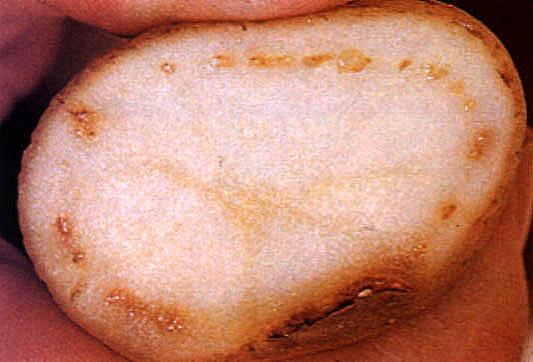Kvalitetssäkring
Provning och kvalitetsarbete SMAK´s system för att klassificera potatis och analysera kvalitén...
Corynebacterium sepenodicum
Angripna knölar uppvisar gula missfärgningar i kärlringen. Missfärgningarna kan tidigt på hösten vara relativt oansenliga, för att senare utvecklas och antaga en mörkare färg, samtidigt som håligheter kan uppstå kring kärlringen. Ur de angripna kärlen kan en varliknande massa pressas fram. Ibland angrips även knölens kärna, som då får en mosig konsistens.
Rötan orsakas av bakterien Corynebacterium sepedonicum. Den odlare som misstänker att hans potatis är smittat av ringröta ska anmäla detta till närmaste lantbruksenhet eller växtinspektör. Vanligen sprids ljus ringröta med:

Bacterial ring rot
Affected tubers have discoloured vascular rings. In the early autumn the discoloration can seem to be quite insignificant, but it later develops and assumes a darker shade, at the same as cavities can form round the vascular ring. A viscid substance can be squeezed out of the affected site. The core of a tuber is sometimes attacked; in which case it acquires a pulpy consistency.
The bacteria of Corynebacterium sepedonicum, which is usually spread by seed, cause the rot. Despite the fact that changing the seed can effectively combat it, the disease is still quite widespread. It is necessary to report the presence of the disease to the National Plant Protection Institute.